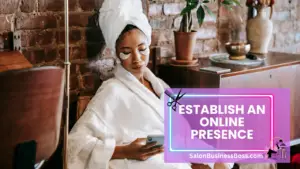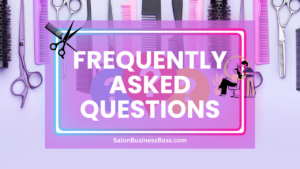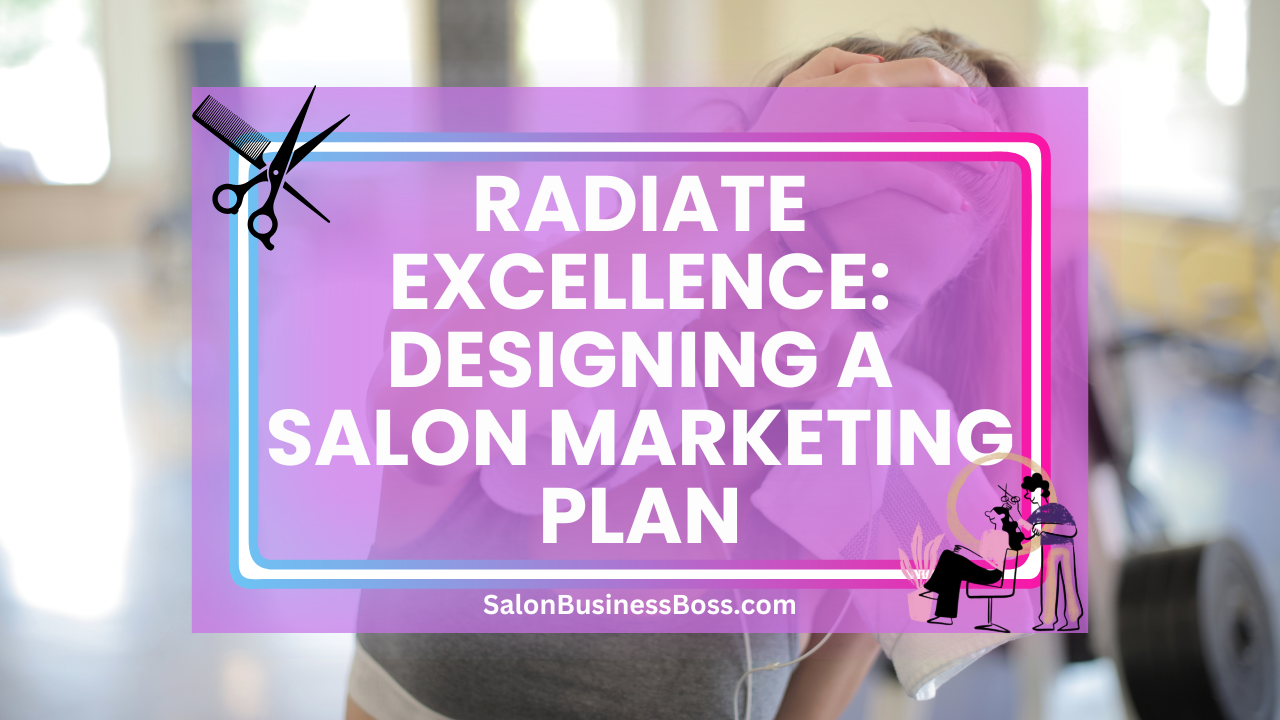A well-crafted marketing plan is crucial for the success of any business, and the salon industry is no exception. In today’s competitive landscape, salons need to effectively promote their services, build a strong brand presence, and attract a loyal customer base. A marketing plan tailored to the unique characteristics of your salon will not only help you stand out from the competition but also foster long-term growth and profitability.
A marketing plan for a salon includes thorough market research, defining a unique selling proposition, building a strong brand identity, and establishing a robust online presence. Content marketing, loyalty programs, and promotions are essential to attract and retain customers. Engage with influencers and track results to refine strategies and ensure long-term growth.
1. Market Research and Analysis:
Before embarking on any marketing strategy, conducting comprehensive market research and analysis is essential for a salon. This process involves gathering relevant data about the industry and local market to gain insights that will inform decision-making. Start by identifying your main competitors and understanding their strengths, weaknesses, and marketing tactics. Analyze their services, pricing, customer reviews, and overall brand perception.
Delve into demographic data to pinpoint your target audience. Understanding their age, gender, income levels, and lifestyle preferences will help you tailor your marketing efforts to resonate with potential customers. For example, if your target audience is predominantly young professionals, focusing on trendy haircuts and modern styles might be more effective.
Market research also involves examining consumer behavior and trends. Identify popular services or treatments in the beauty and wellness industry and explore opportunities for differentiation. Keep a keen eye on emerging trends and incorporate them into your offerings to stay ahead of the competition.
By investing time and effort into thorough market research and analysis, your salon can craft a marketing strategy that aligns with customer preferences, offers value, and positions your business competitively in the marketplace.
2. Define Your Unique Selling Proposition (USP):
In a saturated salon market, standing out requires a well-defined Unique Selling Proposition (USP). Your USP is what sets your salon apart and makes it distinctive in the eyes of your target audience. Start by evaluating your salon’s strengths, and identify what makes it exceptional.
Is it your signature services, such as unique hair coloring techniques or specialized skincare treatments? Perhaps your salon boasts an exceptional team of highly trained stylists or uses high-quality, eco-friendly products. Whatever it may be, emphasize and leverage this unique aspect in your marketing efforts.
Highlighting your USP gives potential customers a compelling reason to choose your salon over competitors. It creates a sense of differentiation and adds value to the overall customer experience. Incorporate your USP into your brand messaging, marketing materials, and online presence to ensure it resonates with your target audience.
Remember that a strong USP is not just about what you offer but also how you communicate it to your customers. Authenticity and consistency in delivering your USP will build trust and foster lasting relationships with clients, making your salon the go-to choice in the competitive beauty and wellness industry.
3. Build a Strong Brand Identity:
A salon’s brand identity is the visual and emotional representation of its essence and values. It serves as the face of the salon, creating a lasting impression on potential customers. To build a strong brand identity, start by developing a visually appealing logo that encapsulates your salon’s personality and style. Choose colors that evoke the right emotions and resonate with your target audience. For instance, soft pastels may convey a sense of relaxation and luxury, while bold colors can signify creativity and energy.
Craft a compelling tagline that communicates the salon’s unique value proposition and resonates with your target customers. Your tagline should be concise, memorable, and aligned with your brand’s mission and vision.
Consistency is key in brand identity. Ensure that all brand elements, including the logo, colors, and tagline, are used consistently across all marketing channels. This consistency fosters brand recognition and builds trust with potential customers. From your website and social media profiles to print materials and signage, a unified brand identity creates a cohesive and professional image.
A strong brand identity not only sets your salon apart from competitors but also helps establish an emotional connection with customers. It communicates the salon’s values, builds loyalty, and encourages repeat business.
4. Establish an Online Presence:

In today’s digitally-driven world, a strong online presence is a fundamental aspect of any successful salon marketing plan. Start by creating a professional website that showcases your salon’s services, team members, pricing, and contact information. Ensure the website is user-friendly and optimized for mobile devices to accommodate the growing number of customers who search for local services on their smartphones.
Leverage social media platforms like Facebook, Instagram, and Twitter to engage with your target audience actively. Share updates, promotions, and photos showcasing your salon’s work. Engaging content can attract potential customers and encourage them to interact with your salon’s social media pages.
Use visual content such as images and videos to highlight the salon’s services, customer transformations, and behind-the-scenes glimpses of your salon’s atmosphere. Visual storytelling fosters an emotional connection with your audience and keeps them engaged.
Encourage customer reviews and testimonials on platforms like Google My Business and Yelp, as positive online reviews can significantly impact potential customers’ decisions.
By establishing a robust online presence, your salon can reach a wider audience, build brand awareness, and foster customer loyalty. Online interactions provide valuable insights into customer preferences, enabling you to adapt and improve your salon’s offerings to meet their needs effectively.
Read more about: Navigating the Digital Landscape: Online Hair Salon Marketing Strategies
5. Content Marketing Strategy:
A well-crafted content marketing strategy is a powerful way to connect with your audience and establish your salon as an industry authority. By providing valuable and informative content, you can attract potential customers and retain existing ones. Create a blog on your salon’s website and regularly publish articles and posts that offer beauty and wellness tips, tricks, and advice. Share insights into the latest trends, seasonal hairstyles, skincare routines, and product reviews.
Engaging content not only builds trust with your audience but also positions your salon as a go-to resource for all things beauty-related. Consider collaborating with industry experts or influencers to add credibility and broaden your content reach. Utilize eye-catching visuals, such as before-and-after photos or tutorial videos, to increase engagement and shareability.
Consistency is key in content marketing. Establish a regular posting schedule to keep your audience engaged and coming back for more. Share your blog posts and other valuable content across your social media platforms, driving traffic to your website and increasing your brand’s visibility.
By implementing a well-thought-out content marketing strategy, your salon can foster strong customer relationships, demonstrate expertise, and ultimately attract more clients seeking reliable beauty advice and services.
6. Loyalty Programs and Referral Incentives:
Loyalty programs and referral incentives are invaluable tools for boosting customer retention and attracting new business. Implementing a tiered loyalty program allows you to reward customers based on their frequency of visits and the services they avail. This encourages repeat business and creates a sense of appreciation for loyal patrons.
Referral incentives tap into the power of word-of-mouth marketing. Offer rewards, such as discounts or free services, to existing customers who refer friends, family, or colleagues to your salon. Satisfied customers are likely to share positive experiences, generating valuable word-of-mouth referrals.
To effectively run loyalty programs and referral incentives, use a user-friendly tracking system to monitor customer points or referrals accurately. Provide clear communication about the rewards and redemption process to ensure customers understand the benefits of participating.
Beyond the direct benefits of loyalty programs and referrals, they also create a sense of community and belonging among your customer base. The sense of exclusivity and personalized treatment can lead to increased customer satisfaction and loyalty.
By prioritizing customer retention and encouraging referrals, your salon can establish a loyal customer base that not only returns for your services but also becomes a powerful advocate for your brand, driving organic growth and brand visibility in the local community.
7. Promotions and Special Offers:
Running well-planned promotions and special offers can significantly impact your salon’s business by attracting new customers and boosting sales. Consider creating enticing deals, such as discounts on specific services or seasonal packages. For instance, you can offer a discounted bundle for wedding hair and makeup during the wedding season or a special package for holiday pampering.
“First-time customer” deals are an excellent way to entice potential clients to try your salon’s services. Offer a discounted rate or a complimentary add-on service to make a memorable first impression. This strategy can lead to long-term customer relationships and word-of-mouth referrals.
Collaborating with other local businesses can also be beneficial. Partner with nearby spas, gyms, or fashion boutiques to create cross-promotional campaigns. This approach expands your reach to new audiences and reinforces your salon’s presence in the local community.
When executing promotions, ensure clear and concise communication through all marketing channels. Use social media, your website, and in-salon signage to promote your offers effectively. Additionally, set clear start and end dates for each promotion to create a sense of urgency and encourage immediate action.
8. Email Marketing:

Email marketing remains one of the most effective ways to engage with your audience and encourage repeat business. Start by building a mailing list by collecting email addresses from your customers and website visitors. Offer an incentive, such as a welcome discount or a free service, to encourage sign-ups.
Sending out regular newsletters is a great way to keep your audience informed and interested. Share updates about your salon, introduce new services, and highlight customer success stories or testimonials. Be sure to include engaging content such as beauty tips, trends, and industry insights.
Personalization is crucial in email marketing. Address recipients by their names and tailor content based on their previous interactions with your salon. For instance, send exclusive offers or rewards to loyal customers to show appreciation for their continued support.
Segment your email list based on customer preferences or demographics to deliver targeted content. This way, you can send relevant promotions and special offers that resonate with specific customer groups.
Remember to comply with data protection regulations and provide an option for recipients to opt-out of receiving emails if they wish. A well-executed email marketing strategy can help nurture customer relationships, drive repeat business, and keep your salon at the forefront of customers’ minds.
Read more about: Navigating the Digital Landscape: Online Hair Salon Marketing Strategies
9. Engage with Influencers and Collaborate:
In the age of social media, influencers and beauty bloggers wield significant influence over their followers. Partnering with them can be a powerful way to expand your salon’s reach and build credibility. Identify influencers and bloggers whose values align with your salon’s brand and target audience.
Offer complimentary services to influencers in exchange for their honest reviews and social media posts about their experience at your salon. Their positive endorsements can create a buzz and attract new customers to your salon.
Collaborating with local businesses is another effective strategy. Join forces with nearby spas, fashion boutiques, or health clubs to host joint events or promotions. Co-hosting events or cross-promotional campaigns allows you to tap into each other’s customer base and gain exposure to new audiences.
When engaging with influencers and collaborating with other businesses, be clear about your expectations and objectives. Ensure that all partnerships align with your salon’s brand values and contribute to a positive customer experience. Cultivate long-term relationships with influencers and collaborators to maintain a consistent brand presence and capitalize on the benefits of ongoing partnerships.
10. Measure and Analyze Results:
Measuring and analyzing the results of your marketing efforts is critical for understanding what works best and optimizing your salon’s strategies over time. Utilize analytics tools to track website traffic, social media engagement, and the success of your promotional campaigns.
Examine key performance indicators (KPIs) such as conversion rates, customer acquisition costs, and customer retention rates to gauge the effectiveness of your marketing initiatives. Analyze which channels and tactics are driving the most leads and conversions.
Customer feedback is equally valuable. Collect reviews and testimonials to gain insights into the customer experience at your salon. Address any issues or areas for improvement to enhance customer satisfaction and loyalty.
Based on the data and insights gathered, refine your marketing approach. Focus on the strategies that yield the best results and discontinue or modify those that underperform. Continuously adapt your marketing efforts to changing customer preferences and market trends to ensure your salon remains competitive and successful in the long run.
Conclusion
A well-thought-out marketing plan is the backbone of a successful salon business. By understanding your target audience, establishing a strong brand presence, leveraging digital marketing, and offering unique incentives, your salon can gain a competitive edge and thrive in the ever-evolving beauty industry. Remember to adapt your marketing plan as needed, staying attuned to customer feedback and market trends to continuously improve your salon’s offerings and customer experience. With a strategic approach, your salon can carve a path to sustainable growth and success.
Frequently Asked Questions

1. What role do influencers play in a salon’s marketing plan?
Influencers can expand a salon’s reach and credibility. Collaborating with local beauty bloggers or influencers can lead to positive reviews, social media exposure, and increased salon visibility.
2. How can a salon measure the effectiveness of its marketing efforts?
By using analytics tools, a salon can track website traffic, social media engagement, and promotional campaign success. Analyzing data helps the salon understand what works best and make data-driven decisions.
3. Can a marketing plan be flexible and adapt to changing trends?
Yes, a marketing plan should be adaptable to changing customer preferences and market dynamics. Regularly assess results and customer feedback to adjust strategies and remain relevant.
To learn more on how to start you own salon checkout my startup documents here.
Please note that the contents of this blog are for informational and entertainment purposes only and should not be construed as legal advice. Any action taken based on the information provided in this blog is solely at your own risk. Additionally, all images used in this blog are generated under the CC0 license of Creative Commons, which means they are free to use for any purpose without attribution.

About the author. Entrepreneur and Salon Business Fan.
Hi! I am Shawn and I am a happy individual who happens to be an entrepreneur. I have owned several types of businesses in my life from a coffee shop to an import and export business to an online review business plus a few more and now I create online salon business resources for those interested in starting new ventures. It’s demanding work but I love it. I do it for those passionate about their business and their goals. That’s why when I meet a salon business owner, I see myself. I know how hard the struggle is to retain clients, find good employees and keep the business growing all while trying to stay competitive.
That’s why I created Salon Business Boss: I want to help salon business owners like you build a thriving business that brings you endless joy and supports your ideal lifestyle.

